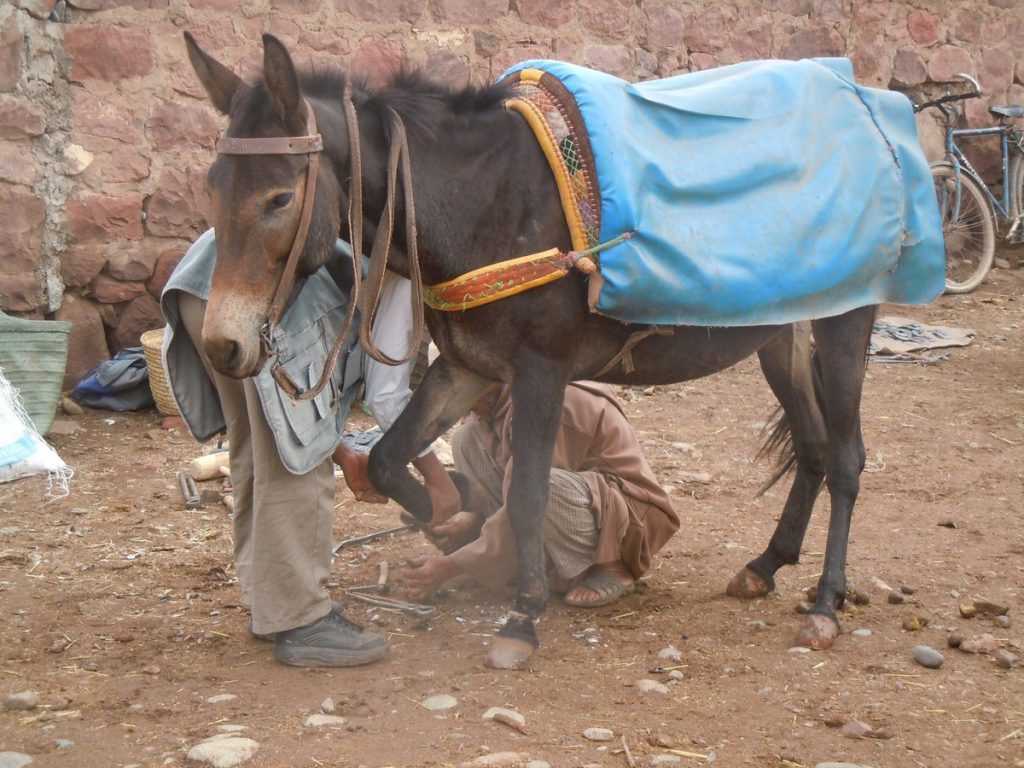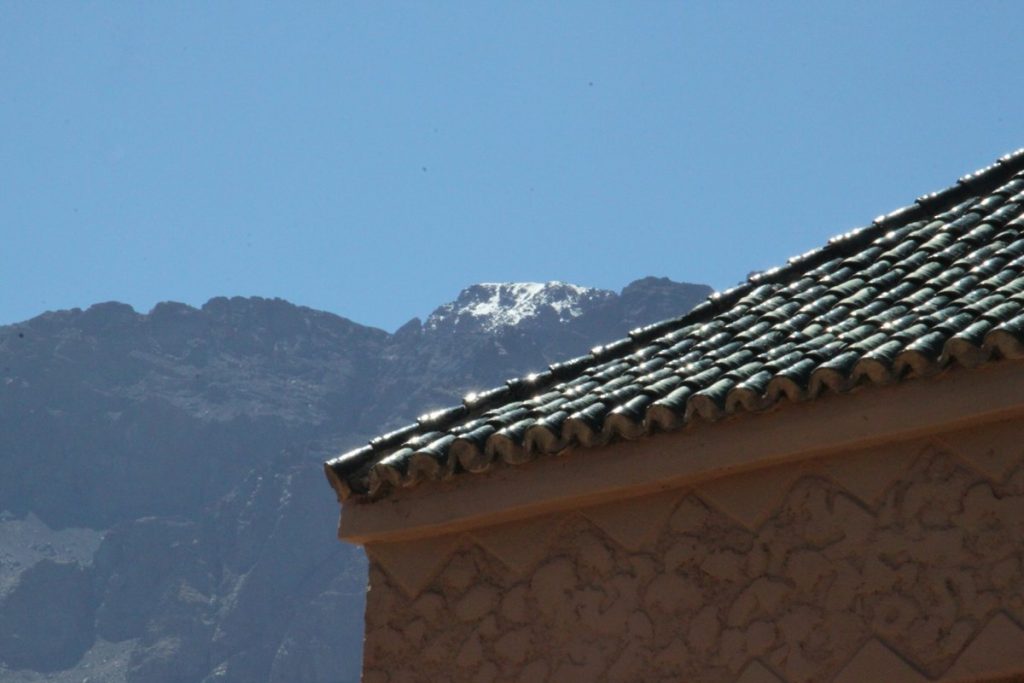We left Marrakech Monday morning on our way to Kasbah du Toubkal, which is near Imlil. It had rained Sunday night and there were plenty of puddles on the streets and alleys. We were told it was unusual to have this much rain at this time of the year. It made it much cooler. Overall we had pretty good weather in Marrakech in contrast to the extreme heat that had been predicted.
Instead of heading directly for Imlil, we went first to the Ourika Valley. It is in the foothills of the High Atlas Mountains. Mustapha wanted us to see the “Monday Market,” which, oddly enough, takes place on Mondays in the Tnine-de-l’Ourika village. The river Ourika, which has been known to flood, runs directly through the village. The market was different from what we had seen in Fes and Marrakech. According to Mustapha, it was more Berber-like. He also warned us to leave all of our valuables in the car because there were some “bad fellows” who would like to take everything. As with much of the trade we have seen, the market was organized into sections.
We first visited an area where sheep, goats, and donkeys were being bought and sold. There were serious negotiations going on and crowds would form around the participants. We saw some donkeys given a speed test—at least that’s what it looked like. There were blacksmiths sitting on the ground shoeing some of the donkeys using tools that were probably the apex of technology more than 1,000 years ago. Patricia tells me they were cold-shoeing” since there was no fire.
People would hold out their hands or rub their thumb and forefinger together and shake their heads no if you even looked like you wanted to take a picture. The market was very large both in terms of size and the number of people there. There were relatively few tourists. In one section there were 25 or 30 barbers. In another there were “dentists.” Their tools looked to even older than those of the blacksmiths. Neither of us was tempted to try that service. [He charged us for the picture.]
There were clothes of every description and often of very bright colors. Ourika Valley is fertile and there were many kinds and large quantities of fruit and vegetables. Because this is primarily a local market, people do a lot of their weekly shopping for supplies here. We saw a lot of food being prepared, but I don’t think we could have been convinced to eat any of it given the mud, dust, and trash.
We saw a different group of blacksmiths who had small fires—not forges—that used charcoal. They blew air on the fires to keep them at a high temperature not with a bellows, but with ingenious pumps using bicycle wheels and chains.
There were a large number of chickens, turkeys, rabbits, and goats who were making their last trip to the market. That made for a lot of mess and noise. Mustapha told us that a lot of the people in the area would buy a little bit of meat from the market and take it home to their families for Monday or Tuesday and that would be it for meat for the week. The market opens early but closes at about 1:00. That is because many of the vendors and buyer had to get up very early in the morning and walk, or ride their mopeds, or use their donkey carts to get there and they needed time to get home.
That market, like so much we have seen, was a real education. We’ll never really understand how people in this area live, but this taught us a great deal—not all of it peasant.
It was only about 30 miles from the Ourika Valley to Imlil. The road began to gradually rise and get more narrow and crooked as we drove into the High Atlas. There were (and are) peaks all around us and our road was generally in sight of a river valley. Adil did his usual good job of balancing caution and making time.
When we reached Imlil, which seems to be a one- or two-street town built on a steep incline, we had to say goodbye to Mustapha and Adil. They were excellent at their jobs, got along well with each other and with us and were great ambassadors for their country. They took us to very interesting places, informed us, and made us feel very well treated indeed.
At a small storefront in Imlil we met Rashid and several others from Kasbah du Toubkal. Did I forget to mention that you can’t get to the Kasbah by car? I don’t mean it is inconvenient, I mean you can’t get there. So how do you travel the 3 or 4 kilometers from Imlil to the Kasbah? Why, on a donkey, of course. All the supplies for the Kasbah get in that way. One got our luggage and two more took Patricia and me. The donkeys were pretty much autonomous, but occasionally one of the porters would encourage progress with a gentle application of a small stick—not! When they needed to be persuaded, they got a lick. It was surprisingly easy for us to make the trip up the narrow winding path. It took about half an hour. We had thought about refusing the donkeys but after seeing the narrow, muddy, uneven, and rocky path we were glad we took the help.
The Kasbah du Toubkal is fairly new having been built in the late 90s. Before it got here, there was hardly any electricity in the 14 surrounding villages and very little off-season work for the villagers. The deserted former compound had been abandoned when the French left in 1956. Everything used to restore the facility had to be brought up the same path we took.
The location is very nice. We are at the midpoint of a valley and are surrounded by hills/mountains on all sides. We are close to the tallest peak in Northern Africa—Jbel Toubkal–which is 13,767 feet high. The Kasbah is at just over 4,000 feet. I mentioned that it rained on Monday and when we arrived it was still raining a bit. Much of the skyline was obscured by fog and clouds.
Our room is OK but not great. The people here are very nice and try to anticipate our needs. After we settled in for a few minutes we took an afternoon hike with Rashid. We went up so that we could see many of the local villages, the irrigation systems, and people gathering walnuts. We had to share the trail with donkeys carrying supplies up and down. Many climbers use Imlil as a jumping off point for treks up to Jbel Toubkal. We saw some snow on it this morning. Apparently, the donkeys take all the supplies, including mattresses and food, to the base camp and beyond and the climbers follow. Our walk ended just as the rain began to fall in earnest. It poured down all night. That made it much cooler at which point we discovered a “feature” of our room: no heat. Yup, no way to heat the room at all. There was, however, an ample supply of blankets. It was far too rainy and the climb up from our room so slippery, that we chose not to go up for dinner. Someone came down and asked if we wanted anything and we said no. I asked if I could phone if I needed anything and he looked surprised: no phone, he said. He was right. There is no phone in our room. No Wifi either, but I can come up to the main area for that.
Tuesday dawned bright and sunny after a night of rain. The valley below us and the hillsides on which the villages sit looks very different today. We were scheduled to spend the day hiking but in view of the muddy and steep paths we decided to just hand around the Kasbah today. We sat on the rooftop terrace and drank tea, took pictures, an relaxed. Our day has been so strenuous that Patricia was forced to take a nap this afternoon. I took mine this morning while sitting on the terrace in the bright sun and cool temperature and listening to the sounds of children from one of the villages, the calls of donkeys and other farm animals, and the chatter of the staff. It was very pleasant.








Kate Jacobs
25 Sep 2012I love the pictures from this post! The photo of you and Mom on the donkeys is priceless. Dad – you look like Indiana Jones! Love it!
Tevya
26 Sep 2012I love, love, love the pic of the two of you on donkeys! I never thought I’d see either of you doing that. How much does it cost to take a picture of someone in the markets?